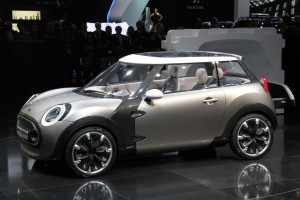With the new Paceman coming onboard, Mini will now offer a total of seven different models – never mind all the variants it is delivering to showrooms around the world. But the maker is far from done as it fleshes out its line-up, company officials say.
If anything, “Our management has said that in the future a full line-up of vehicles for the brand could be 10 models,” suggested David Duncan, Mini USA’s sales director, during a conversation in Puerto Rico, where the Paceman is getting its first media drive.
Exactly what’s in store, Duncan and other Mini team members weren’t ready to discuss – beyond hinting they’re looking to fill “any segment that makes sense for a small car.”
In fact, small is apparently a relative term for the British maker, a subsidiary of Germany’s BMW. Mini delivered a shock to many traditionalists when it introduced the Countryman, a couple years back, not only the first four-door model and the first with all-wheel-drive but also the brand’s biggest offering ever.
Asked whether Mini might just move into an even larger segment, Duncan offered that, “I don’t know if there’s any limit – but whatever segment we play in,” he cautioned, “we will be the smallest player.”
One of the offerings Mini would like to add is a production version of the well-received Rocketman Concept. It currently doesn’t have a platform that would work with the Rocketman. One possibility would be to partner with another maker, according to Patrick McKenna, Mini’s manager of product planning, though it appears the BMW subsidiary might prefer to wait and eventually develop the needed hardware on its own.
The bottom line is that Mini’s ambitions are anything but small. When the maker was launched in the U.S. market in 2002 it offered just a single product line and was aiming for a modest 20,000 annual sales.
In 2012, Mini sold a record 66,123 vehicles in the States – indeed, it hit sales records during nine months last year, and last month was the brand’s best January ever. The Hardtop was the brand’s most popular model, with more than 29,000 sales, followed by the Countryman which generated another 21,000. Together, those two products were responsible for 75% of the brand’s total American volume.
The U.S., meanwhile, was Mini’s top market, accounting for about 23% of global sales.
“That’s amazing,” gaped Duncan, when you consider that American consumers (still) love gas-guzzling SUVs.”
The maker, he concluded, sees opportunity for “moderate growth” in 2013, “driven by the (new) Paceman.”
Meanwhile, don’t be surprised to see Mini’s powertrain line-up grow, as well. It’s too late in the lifecycle of the Hardtop, said McKenna, but “We can definitely envision (a diesel) for the next-generation, though we’re not going to confirm it.”
Mini is one of only a handful of European brands that has not already added a high-mileage diesel to its U.S. line-up. It would simply be too complicated and expensive to do so with the outgoing Hardtop, McKenna explained.

